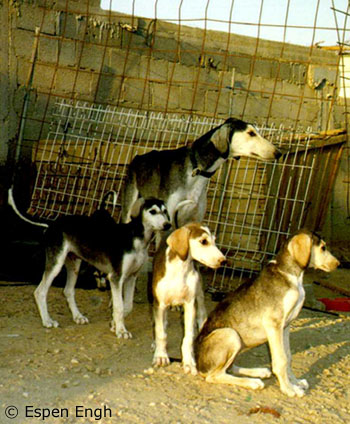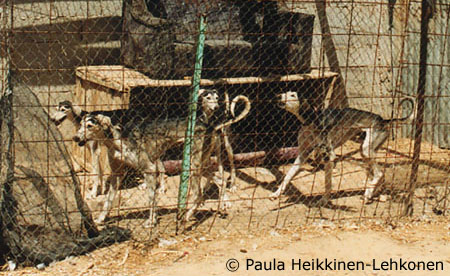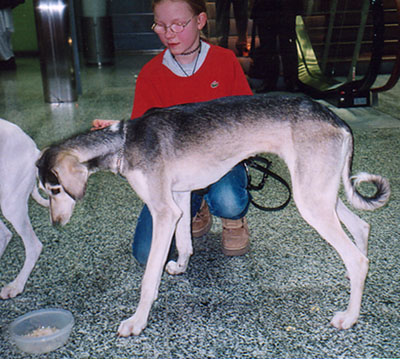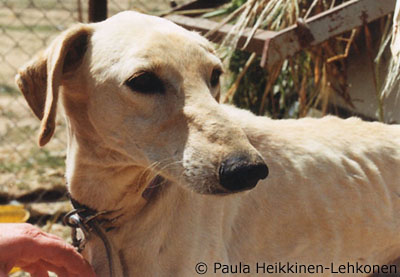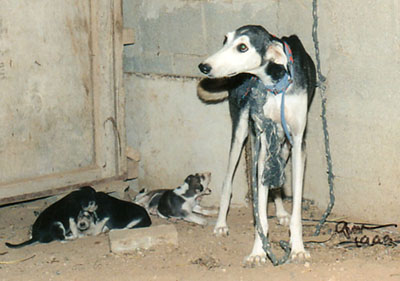|
|
|
|
|
I
first fell in love with a Saluki at age 8. She was a small Saudi Arabian
bitch, the clever heroine of a children's story. And so my mind was
made up: one day I would live with Salukis, breed Salukis, write about
Salukis… and one day I would own a real desert bred beauty of
my own. The years passed, my Saluki family grew and so did my interest
in the Eastern Saluki. I asked breeders why they did not import from
the desert and was told it was next to impossible and in any case
they did not want to risk losing their established kennel type by
bringing in the unknown.
|
|
|
|
He had mated the half-siblings Regab and Risha, both grizzle smooths
and both sired by a local legend, his own Pontiac. The result
was a litter of four, two males and two females, from which Zafra
selected my Farha, also a smooth grizzle. Farha al-Faifa remained
with Sultan until 6 months of age when Zafra fetched her and took
her to Tel Aviv. For the first time in her life Farha walked on
a lead and rode the elevator to Zafra's flat, where she delightedly
made the acquaintance of Zafra's Greyhounds, ate their food and
fell asleep on their bed…
|
|
|
|
The dogs live in a makeshift kennel - old Pontiac sports the locally
popular version of a doghouse: part of an old car with a grass roof!
Pontiac is well-known among the other Bedouins as a hunter and stud
dog and is also a rarity because of his age -9 years- as most Negev
Salukis have a life span of 5 to 6 years as they are then replaced
with younger, stronger hunters. Hunting is illegal in the state of
Israel, but the Bedouins still relish this ancient practice, driving
out into the desert at dusk with their Salukis, hoping to hunt away
from prying eyes.
|
|
|
|
February
11 2000 our long-awaited puppies finally arrived at Helsinki airport.
Farha was then 8 months, Safi 4,5 months old. The pups impressed us
greatly from the get-go not only with their beauty and soundness but
also with their unflappable temperaments. No sooner had they stepped
out of their crates than they began eating from the bowls set before
them, smack in the middle of a busy terminal! Once they had eaten
they just as calmly allowed themselves to be admired and photographed
by our entourage of ten. "They're lovely!" I kept telling
Zafra, "they're lovely!"
|
|
|
|
Farha quickly made friends with my other dogs, two Salukis and two
Dachshunds. I had worried that she might not like the smaller dogs
but I needn't have, all went well though she was a little puzzled
by them at first. Food was a problem in the beginning as Farha seemed
under the impression that whoever got to the bowls first ate that
day. She would guard her food ferociously (though not with me, only
the dogs), gulp it all down and then go outside to throw it up and
eat it again at her leisure. By now she's learned to wait her turn
and eats calmly with the others. She is a joy to look at and live
with and I could not be happier with her.
|
|
|
|
Since
neither Farha nor Safi have more than two documented (and thanks to
Zafra's work, registered) generations in their pedigrees, they've
gone into a special registry here. This means that they can compete
for national but not international titles. Their offspring will have
full FCI registration as long as their intended mates have at least
two registered generations in their pedigrees. I hope to use both
in my breeding.
Micaela Lehtonen |

